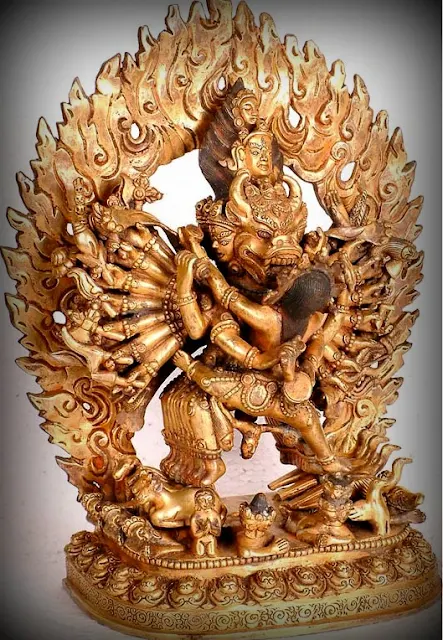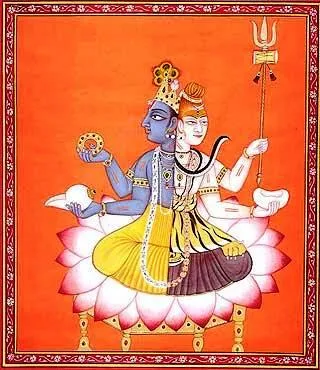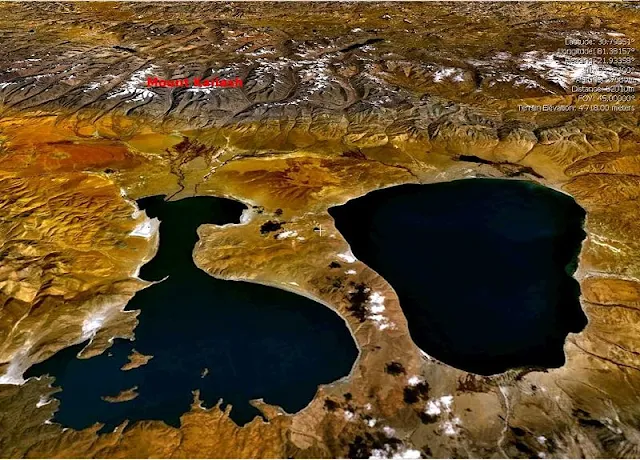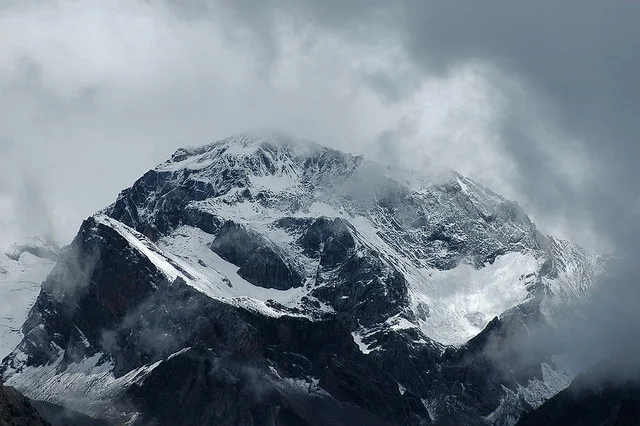Om tryambakaṃ yajāmahe sugandhiṃ puṣṭi-vardhanam
urvārukam iva bandhanān mṛtyormukṣīya māmṛtāt
The above verse from Rigveda [7.59.12], known as the Mahamritunjaya or the Death-conquering Mantra is dedicated to Lord Shiva. Ironically, it is Shiva Himself who is revered as the harbinger of the final Destruction of the World!
Who is Shiva? What are the origins of this mighty god in Hindu religion and what are the different facets of His personality? In this post, let us try to analyze this enigmatic god and learn what it means to be the Lord of Destruction..
Shiva, the Destroyer
- Brahma , the First in the Trinity, is the Creator and Master of all Divine Ceremonies.
- Vishnu, the Preserver god who incarnates to help mankind face the challenges posed whenever Evil forces become too dominant in the Universe.
- Shiva, destroys at the End of Time and thus sustains the endless rhythm of the Universe ensuring a continuous cycle of renewal and growth.
 |
| Mahadev-Shiv-Pashupati-Rudra |
That the Mahabharat follows the Indus perception of Shiva again shows that the two developed same imagery and that this penultimate battle between Good and Evil occurred around the same time as the Indus-Saraswati Civilization! In an article titled {The Riddle of India's Ancient Past}, the French proto-historian Michel Danino believes there are strong links between Vedas and the Harappan culture.
'We find statues and seals depicting yogis and yogic postures, we find a Shiva-like deity, worship of a mother-goddess, fire altars, all of which are suggestive of Vedic culture. Harappan symbols include the Trishul, the Swastika, the Conch shell, the Peepal tree, all of which are central to Indian culture. The Rig-Veda itself is full of references to fortified cities and towns, to oceans, sailing, trade and industry, all of which are found in the Harappan civilization.'
 |
| Pashupati Seal from Indus-Saraswati excavations |
As you probably know from my other posts, I love to find out the similarities between the mythologies from different parts of the world. Keeping up with the tradition, I here share with you the image of the horned god Cernunnos worshiped in Europe around 1st century CE.
 |
| The Horned Gods - Pashupati & Cernunnos |
In Yajurveda, the contrary attributes are referred to as Rudra, the terrifying and Shiva, the auspicious (Sanskrit Shiv = Shubh). Some scholars believe Rudra to be the older form which was merged later with a 'Non-Aryan' god Shiva or Pashupati in later times. But do the scriptures support such a hypothesis?
 |
| Shiva, the Consummate Yogi |
Shiva or Rudra?
The story of Rudra's birth is very interesting and is identically revealed in many Puranas.
This, however, frustrated Brahma so much that from his forehead, (the region of the third eye) emerged a dark red/blue child bawling at the top of his voice. This angry baby was named Rudra (The Howler)!
 |
| Rudra born from Brahma's Frown |
Thus, we see, that the scriptures find NO difference between Rudra and Shiva except that the first term encompasses eleven gods, the First and Foremost of whom is Lord Shiv. Therefore, the hypothesis that Shiva was a non-Aryan god who was merged with Rudra is baseless.
 |
| Lord Shiv with the Rudras |
 |
| The Deep Seated Third Eye |
 |
| Shiva, the only being with a Completely functional Pineal Gland? |
Shiva and Shakti
Rudra, thus took the form of Ardhanarishwar and generated a female principle from His left half who was the Rudrani. Each of the 11 Rudras similarly obtained a consort thus providing Brahma some satisfaction of seeing his creations multiply. Shiva's consort Uma or Shakti is the primeval Goddess who also represents the Yogmaya of Lord Vishnu.
 |
| Lord as Ardha-naarishwar |
 |
| Shiva with His beloved Sati in happier times |
 |
| Yamantaka Shiva in Yab-Yum formation |
Archaeologically, we find this reflected in the Zebu bull seals of Indus-Saraswati Civilization (which may represent Nandi) and surprise, surprise, in a far-off valley in Turkey known as Yazili Kaya! The rock-cut friezes in these caves belong to 16th-17th century BCE and show a God Teshav riding a bull, while the accompanying Goddess Hakat rides a Lion and is accompanied by a young boy Kumarbi (Kumar Kartikeya?).
 |
| Yazili Kaya rock-cut frieze with God on Bull and Goddess on Lion |
 |
| Zebu Bull from Harrapan seals |
Sati did eventually marry Lord Shiv against her father's wishes and ultimately sacrificed herself in the Yagnya fire at Kankhal, Haridwar to protect her husband's honor. Shiva carries the corpse of Sati on His shoulder lamenting His loss till Lord Vishnu uses His Chakra to disintegrate the body. Each part of the body falling on Earth provides a Divine foundation and thus are formed the 51 Shaktipeeths (Seats-of-Energy)!
This incident shows that Shiva and Vishnu work in tandem too and their Oneness-in-Duality is also seen in the combined form of Vishnu (Hari) and Shiva (Har) that depicts both deities as two faces of the same coin working hand-in-hand to ensure smooth functioning of the Universe.
 | |
| Hari-Hara the Divine combination of Lord Vishnu and Lord Shiva |
 |
| Virbhadra , born from Shiva's locks beheads Daksha |
 |
| Virbhadra statue carved out of rock at Kailash Temple, Ellora |
Kailash, the Abode of Shiva
Talking about Kailash, the holy mountain is believed to be the abode of Shiv and Parvati. There are many mentions of it in the various Puranas and other scriptures like Ramayan and Mahabharat. The mountain is sacred for not only Hindus but also Buddhists, Jains and followers of Bon religion.
 |
| Satellite Image of Mt. Kailash with Mansarovar and Rakshas Taal |
 |
| Catching a glimpse of the Holy Mountain |
The followers of Bön religion credit the entire region, especially Kailash, as the seat of all spiritual power. Indeed the area gives one a feeling of entering a more spiritual plane especially when you see mountain peaks like that of the Om Parvat.
 |
| View of the Om Parvat en route to Mount Kailash |
These verses in the Vayu Puraan, Chapter 39 shed more light on the details of this place:
[230] Beyond Brahmaloka and beneath the upper crust of the Cosmic Egg – in between these two is Shiva’s city, his divine abode called MANOMAYA.
[238] The city shines with scattered diamond dust. These worlds are lit from within, meaning their reality does not consist of reflected light, as does our material world.
[264-266] Lord Maheshwar [the transcendent Lord Shiv] of ten arms sports therein… He is respected and diligently worshiped by the people moving about in aerial chariots.
This, then is the Original and Supreme abode of Shiva where He resides till the end of Creation and is visited by the other gods in their space-crafts {Check the post Lokas or Alien Planets for more on this topic}. Kailash may actually be the temporary home where the Lord comes for a small time, maybe as a summer-retreat!
 |
| Shiva Family on Mount Kailash |
Since Hindu Timelines begin close to 155 Trillion years (the present age of Brahma), hence, obviously Lord Shiv would have had to live somewhere else before finally making Kailash His home!! Also, the Himalayas wont stay forever as the Pralaya or the End-of-the-World would destroy the World as we know it and Brahma would then remould it into a new shape.
At that time, Shiva would probably return to the abode known as Manomaya with His family and Kailash may or may not come into being again.
Naimittik Pralaya
The destruction that takes place at the end of a daytime of Brahma is referred to as Naimittik, implying incidental or occasional opposed to Prakritik Pralaya that takes place at the end of Brahma's lifetime. {Check the post - Pralaya, the End of Days for more on this}
The characteristic of this destruction is that the three worlds (Bhur, Bhuvah and Swarga) continue to exist but are made uninhabitable. The souls of individuals also continue to exist to be reincarnated in the next daytime of Brahma.
The Shiv Purana [2.3.20.14-19] states that the fall off of the energy residing in the THIRD EYE of Shiva fell like lightning and Brahma had to take it to the ocean and keep it under check there else it could burn the entire creation!
The energy thus released was stored underwater in the shape of a mare and is known as the Vadava {Check this link for details - On Wings of Fire}. The fire-mare resides under the ocean (Molten Earth's core?) and one of the myths calls her wife of Yama and hence a harbinger of Death.
Swayambhu Manu alludes to this fire from Shiva's eye stating that in two cases Fire is born out of Water. One, at the time of Lightening and secondly, in the case of the under-water Vadava Mare. Brihadaranyak Upanishad [1.1.2] states that the open mouth of this mare keeps releasing fire in the Sea from time to time, perhaps alluding to submarine eruptions common in the ocean floor!
Normally, the fire is kept in check with the waters of the Global Ocean. But as Mahabharat verses [12.248.13-17] state, the end of the Day of Brahma is nigh that Rudra sparks off the fire again and this explosion from the mare's mouth in the Southern Ocean begins the process of Pralaya.
Vishnu Purana [1.7.24-40] also agrees that this destruction would begin with an underwater explosion and shall be succeeded by a 100 year drought during which the seas, rivers, and streams will all be drained of water. The sun would be replaced by seven suns (will our Sun increase in size?), and the three worlds as well as the underworlds shall be burned bare of life. This then, is the Final Destiny of our planet and this is what we call Tandav, the Final Dance of Shiva. As each atom is created, another is destroyed and this continues forever in a cyclical manner.
I conclude this post with the invocation I started the post with as there is nothing better to pray for except getting out of this Samsara Chakra. This Mahashivratri, let us remember the Lord with our hearts and minds and pray for deliverance:
Om tryambakaṃ yajāmahe sugandhiṃ puṣṭi-vardhanam
urvārukam iva bandhanān mṛtyormukṣīya māmṛtāt
OM, We worship Shiva, the Three-eyed fragrant Lord,
Who nourishes and nurtures all beings,
As is the ripened cucumber freed from its bondage (to the creeper),
May He liberate us from Death and take us to Immortality.














